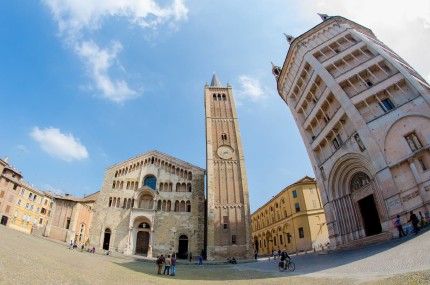Parma: The challenge of extending an UVAR
Parma – a culinary center with a renowned university in the heartland of the Emilia-Romagna Region in Italy. Exploring the centuries-old city center and the surroundings by foot or bike is an experience, but one of the downsides is the air pollution from passenger cars.

Even though the City of Parma has already implemented Urban Vehicle Access Regulations (UVARs) in the city center, and even called it ‘Green Zone’ to give it a positive spin, the pollution in the surrounding region remains a challenge. The plan of the Italian city is to extend the ‘limited traffic zone’ to the entire area inside the city’s ring road. In order to achieve this ambitious plan, Parma received support from the Dynaxibility4CE project in the framework of a morning workshop, which took place on 4 June 2021.
After a brief introduction from Wolfgang Backhaus (Rupprecht Consult), an overview of the different types, challenges and opportunities of UVARs was given by Laura Babío. The project officer from POLIS Network introduced the topic of UVARs by highlighting the different shapes and forms of access regulations, while recapitulating the results from the Dynaxibility4CE UVAR workshop. This was complimented by a detailed explanation of the ReVeAL approach towards UVARs. The EU-funded project with several ties to Dynaxibility4CE offers various guides for the various pathways towards the establishment of limited traffic zones or low-emission zones.

The segment was concluded by highlighting several success factors for UVARs, such as the importance to include UVARs in a wider mobility strategy, by focusing on the functional urban area around the regulated zone. According to research presented by Babío, an inclusive approach with a strong focus on an extensive communication campaign should lead to wider acceptance among the general population.
Now, it was the turn of Parma to shed light on the current situation and upcoming plans for the future. There is a sense of urgency, as Parma is located in the middle of the Po Valley, one of the most polluted areas in Europe. The status update, which was presented by Dina Ravaglia, highlighted that nearly 40% of the historical center already is a low traffic zone and that significant efforts were made to renew the public transport fleet. Additionally, the Parma ‘sustainable urban mobility plan’ (SUMP), which was created in March 2017, will be the framework for the new LEZ inside the ring road. The LEZ is planned to be launched in April 2022.

Currently, the main challenges of Parma are the creation of a detailed communication strategy for citizens and to find sufficient manpower to support it. The strategy is necessary, as citizens are largely uninformed about the potential new measures, which would expand beyond the established LEZ in the city center. A solution to create an automated information gathering system to register the entering cars is another significant challenge.
The information exchange between Parma, POLIS Network and Rupprecht Consult was followed by an interactive part around a digital whiteboard to structure the current context of the UVAR extension in Parma. Several guiding questions about key stakeholders, available resources and potential scenarios towards UVAR implementation were asked. In a next step, a brainstorming of the status was conducted, which was focused on the aspects of technological and organizational needs, as well as the focus on potential incentive- and control systems. These and other categories are the so-called system design components, which should help to structure the future tasks in a more detailed way.
